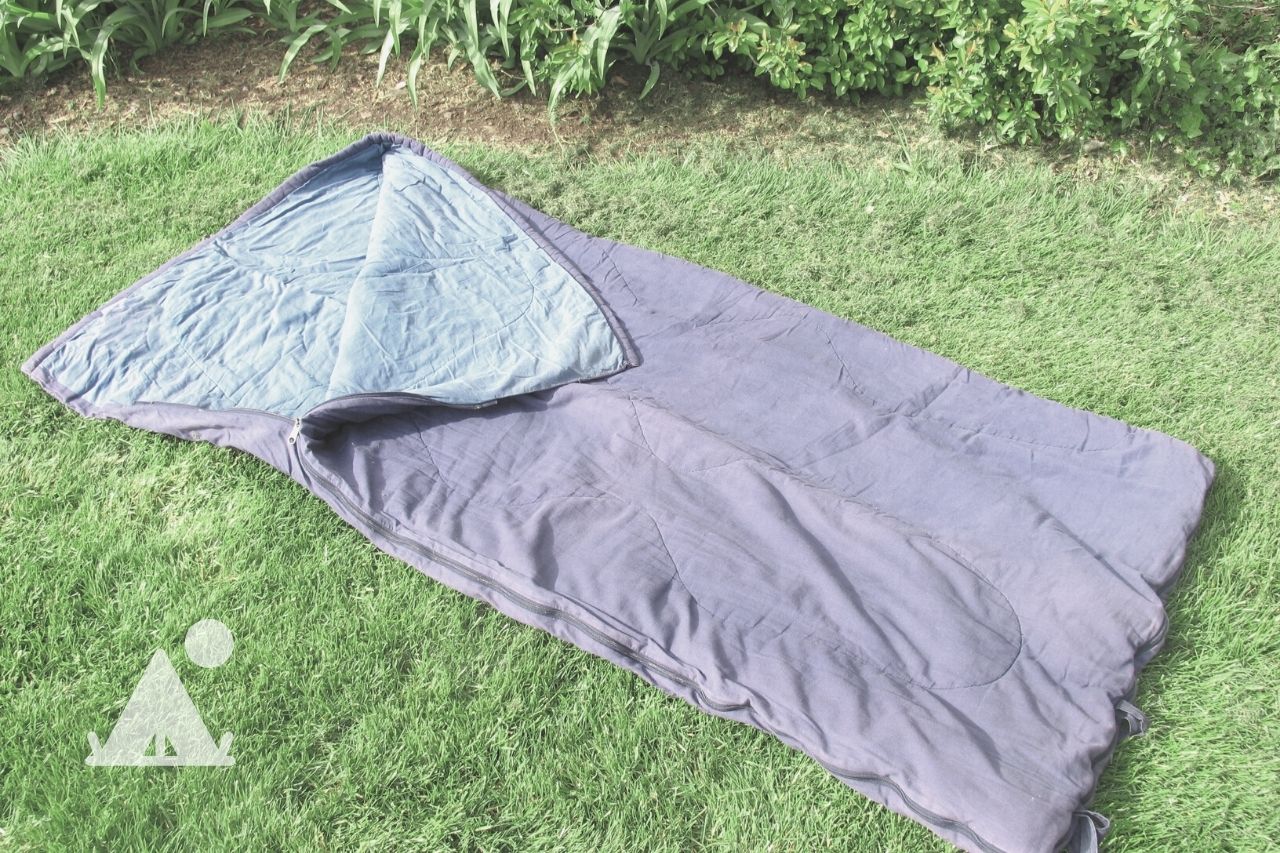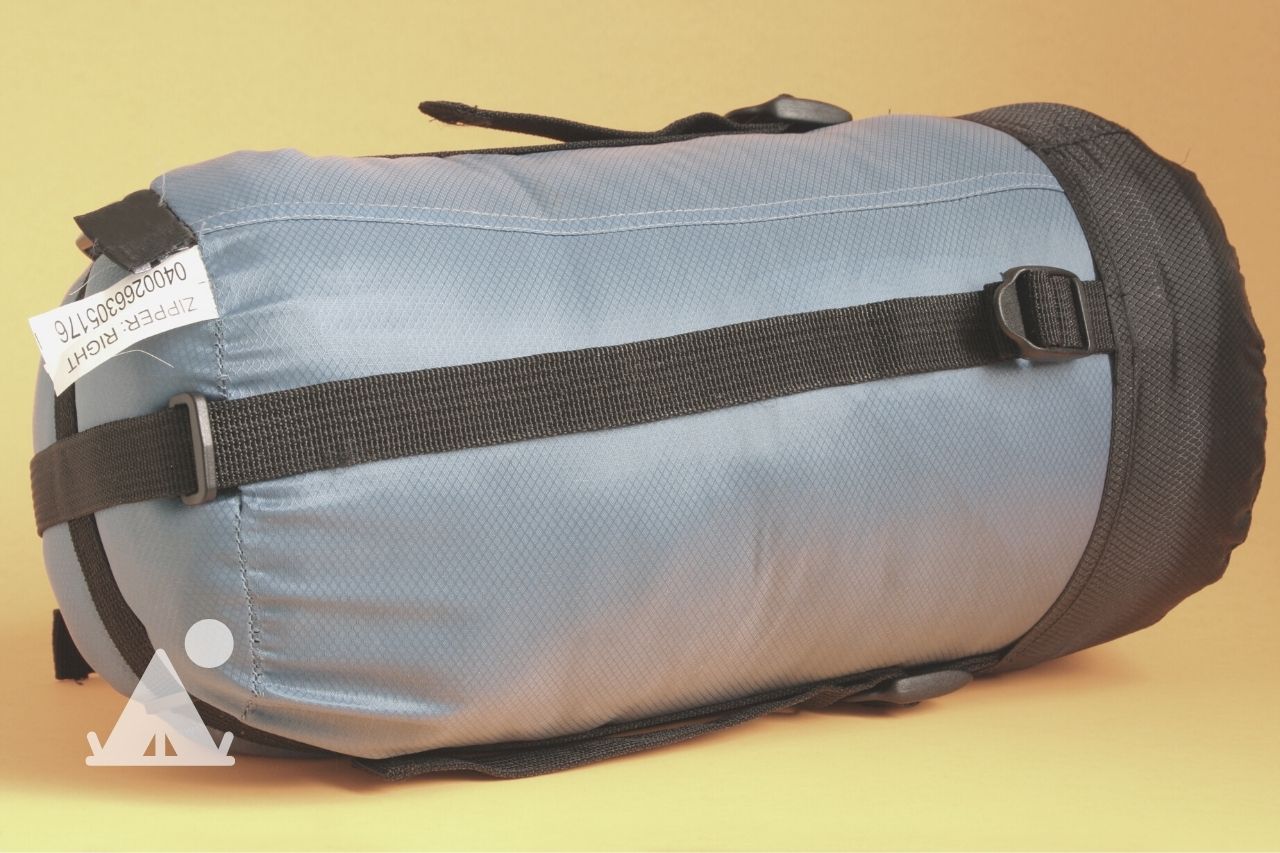New sleeping bags come tightly rolled up in a sack. Many campers and backpackers make the mistake of trying to pack their sleeping bag the same way. In this guide, we show you how to compress a sleeping bag without rolling it, which is not only difficult, but can also damage the sleeping bag.
Is It Bad To Compress A Sleeping Bag?

Before we explain the various compression techniques, is it a good idea to compress a sleeping bag in the first place?
Yes, it is totally safe to compress a sleeping bag. In fact, that’s how sleeping bags are meant to be packed for easy portability.
When spread out, a sleeping bag gets big and fluffy because of all the trapped air within the filling. Imagine trying to carry it as it is when hiking.
Compressing a sleeping bag pushes this air out, making the bag smaller and easier to stuff into a sack.
Compressing a sleeping bag will not damage it as long as you do it the right way. Also, and we’ll talk about this more further below, do not keep the sleeping bag compressed all the time; only when on the go.
Should You Roll Or Stuff A Sleeping Bag?
There are two ways to compress a sleeping bag:
- Rolling
- Stuffing
Most sleeping bags come rolled up when new. This drastically reduces their volume, making them easy to fit into small sacks.
But once you take out the sleeping bag, you’ll find it really difficult to roll it up again into the same tight fit as before.
Stuffing a sleeping bag is so much easier. It’s also better for the longevity and performance of the sleeping bag.
3 Reasons Why Stuffing, Not Rolling, A Sleeping Bag Is Better
1. It’s easier and quicker
Sure, you can quickly roll up a sleeping bag. But it’s super difficult to roll it up tight enough to fit it into the sack it came with.
It takes a lot of time and requires quite a bit of arm strength. It’s tedious work to roll up a sleeping bag every morning when camping.
In contrast, stuffing a sleeping bag takes less than two minutes. Watch the video below to see how easy and quick it is to stuff a down or synthetic sleeping bag into a compression sack.
Even if your sleeping bag came rolled up when new, do not attempt to re-pack it the same way. Most likely, there are machines or experienced workers at the factory that make that tight roll.
Stuffing is the easiest way to compress a sleeping bag.
2. Your sleeping bag will last longer
The biggest problem with rolling a sleeping bag is the stress it puts on the fabric and filling.
After some time, you’ll notice the filling has split down the middle. That’s because when rolling a sleeping bag, you first fold it lengthwise in half.
This split in the middle affects the performance of the entire sleeping bag, and reduces its longevity.
The rolling action is also bad for the sleeping bag. Because you have to do it really tightly, there’s a lot of tension on the fabric and filling, which affects the performance and durability of the sleeping bag.
Stuffing a sleeping bag doesn’t pull at the fabric or filling. There’s little to no risk of damage.
3. Your sleeping bag will stay fluffier
One of the consequences of stress caused by rolling a sleeping bag is that it becomes less fluffy over time.
Tightly rolling the sleeping bag causes the down or synthetic filling to gradually lose its ability to fluff up again. The sleeping bag becomes less warm.
Stuffing is gentler on the sleeping bag, and you’ll find that it fluffs up again easily when you spread it out.
Get a Good Quality Compression Sack
In many cases, the stuff sack your sleeping bag came in is good enough. In other cases, it’s low quality and a bit too small to stuff the sleeping bag.
Before you go camping, consider whether you should invest in a new compression sack.
Compression sacks are great for storing bulky items like sleeping bags and jackets into a compact size that’s easy to travel with.
We recommend buying a waterproof compression sack to protect your sleeping bag from the elements. It should also have good stitching and a strong material so you can confidently stuff it without worrying about bursting the seams.
How To Stuff a Synthetic Sleeping Bag?

- Lay the sleeping bag on a clean surface (like a sleeping pad) with the zips closed.
- Flatten out the sleeping bag as much as you can with your hand. This removes any excess air trapped in the sleeping bag.
- The best compression technique is to stuff and stack. Do not stuff the whole sleeping bag at once. Start with the foot (usually the thickest part of the sleeping bag) and stack the rest of it until you push in the hood.
- Lift the foot of the sleeping bag and scrunch it up. Then push it into the stuff sack all the way to the bottom.
- Grab more of the sleeping bag and stuff it into the sack, making sure you push it to the bottom to create space at the top.
- Keep rotating the sack to evenly distribute the sleeping bag around it. Keep stuffing until the hood of the sleeping bag gets into the sack.
- Secure the sack’s drawstring and put the cap in place, if it has one.
How To Stuff a Down Sleeping Bag?
Follow the same process when stuffing a down sleeping bag. Down sleeping bags pack smaller, so they are easier to stuff and you can use a smaller stuff sack.
But be careful when handling a down sleeping bag as it’s more delicate. You should still stuff it inside the sack as tightly as you can, but be careful not to pull on any part.
Another tip is to turn the sleeping bag inside out.
Many down sleeping bags have a waterproof exterior layer. Turning it inside out makes it easier to expel air as you stuff it, so you don’t end up with a balloon of a bag that won’t fit in the sack.
It also allows the filling to breathe as you travel around. Any moisture that may have been trapped in the down filling overnight evaporates away.
How To Compress A Sleeping Bag Without A Stuff Sack?
If you don’t have a compression sack, the next best alternative is a backpack or travel bag. It’ll not contain and compress a sleeping back as tightly as a compression sack, but it can work in a pinch.
Some backpacks, especially those designed for hiking or backpacking, have dedicated compartments for a sleeping bag. Try stuffing the sleeping bag in there or any other small compartment.
Do not stuff the backpack into a large compartment as it’ll take up all the space.
If you plan to pack your sleeping bag in your backpack everytime you go camping, here are some tips to make it easier.
- Just get a compression sack. If you are on a budget, look for one that’s not waterproof. Once you stuff the sleeping back in the sack, you can then put it in the backpack.
- Get a bigger backpack that can easily fit a sleeping bag in one of the compartments.
- Upgrade to a down sleeping bag. It takes up way less space than a synthetic sleeping bag with a comparable temperature rating.
- Fold up your sleeping bag then tie it with string or a strap before stuffing it into the backpack. It’ll help keep it contained.
- If you have to use the biggest compartment in the backpack or travel bag, stuff the sleeping bag at the bottom and then stuff additional items on top to keep it compressed.
Sleeping Bag Long Term Storage
Compressing a sleeping bag is only for when you are on the go and need to save space.
Keeping your sleeping bag in a compression sack even after you get home is a bad idea. Long term compression gradually degrades the sleeping bag’s ability to fluff up and fill with air once you spread it out.
Thus, it loses some of its insulation power and becomes less warm.
When you get home, wash the sleeping bag if needed, and spread it out to air either indoors where there’s good ventilation or outdoors away from direct sunlight.
After a few hours of airing and drying, stuff it loosely in an oversized mesh or fabric bag. If you don’t have one, use a large pillow case.
The most important thing is to make sure the sleeping bag is not compressed. It should also breathe, so don’t store it in a polythene bag like a garbage bag.
Store the sleeping bag in a cool and dry place like the closet. Just make sure there aren’t pests like mice waiting to attack it.